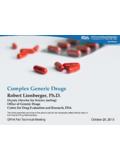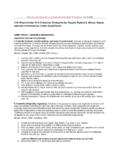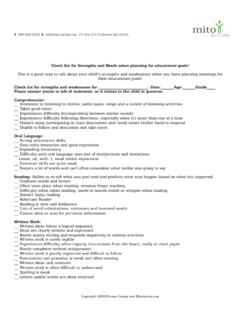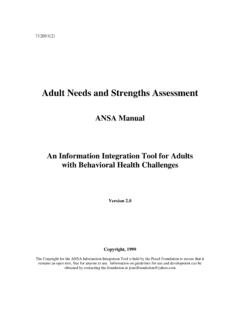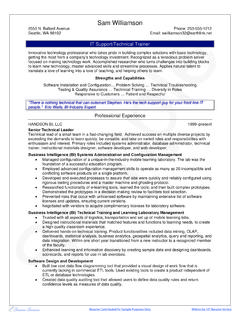Transcription of ANDA Stability Guidance Opportunities & Challenges
1 ANDA Stability Guidance Opportunities & Challenges Upinder S. Atwal, Team Leader OGD/CDER/FDA GPhA/FDA CMC Workshop June 3, 2014 1 Agenda Introduction Opportunities & Challenges Conclusions 2 Introduction Guidance for Industry ANDAs: Stability Testing of Drug Substances and Products Guidance for Industry ANDAs: Stability Testing of Drug Substances and Products Questions and Answers 3 Introduction contd. History of development 2011, 2012, 2013 Presentations, and in- house meetings held with stake-holders and FDA including GPhA Workshops Questions from the Industry and GPhA were collected for responses; draft Q&A Guidance was published Two webinars (DIA, and SBA) were hosted by the members of the Stability working group 4 Implementation June 20, 2014 is the implementation date The Q&A Guidance will assist in the adoption Referenced ICH Stability Guidances: Q1A(R2) Stability Testing of New Drug Substances and Products with Glossary Q1B Photo Stability Testing of New Drug Substances and Products Q1C Stability Testing of New Dosage Forms Q1D Bracketing and Matrixing Designs for Stability Testing of New Drug Products Q1E Evaluation of Stability Data 5 Opportunities Multiple API Sources A minimum of two lots of API to be used for making the primary batches Allowance for proposing two API sources at the time of original ANDA submission 3 submission batches from one source, and one submission batch from the second source See Q & A document DMFs are already following ICH requirements for submission purposes 6 Challenges Multiple API Sources API Batches made under GMP are to be used for manufacturing DP batches Batches made with technical grade API will be considered as supporting data.
2 But not considered as primary batches 7 Opportunities and Challenges Batch size Definition of small scale batch size for ANDAs provides the industry some basic concept of how small a small scale can be accepted Oral solids, liquids, sterile solutions, transdermal patches etc. Small scale batch size is not the same for all dosage forms Orals at least 10% of production batch but not smaller than 25% of pilot scale (25,000 units/tablets/capsules ) Powder/solution/suspension: at least 10% of the proposed commercial scale, but not less than 25% of the pilot scale Parenterals at least 10% of proposed commercial scale, or 30 L (if fill volume is mL or less), or 50 L (fill volume > mL), which ever is larger, packaged. 8 Opportunities and Challenges Batch Size contd. Transdermal Patches at least 10% of the proposed commercial batch packaged, but not less than 60% of the pilot scale packaged; for different strengths (identified by patch size/surface area) three distinct matrix laminates are recommended Topicals, non-sterile (creams, lotions, and gels) at least 10% of the proposed commercial batch, but no less than 40% of the pilot scale packaged Placebo/inert tablets where needed: Only one batch to be made and submitted at the filing time.
3 The final packaging presentation including placebo will need 6 months accelerated and long-term Stability data at the time of submission 9 Exception to ICH batch size- Opportunity The submission ANDA batches can have a smaller size than the established pilot scale, according to the ICH definition, under the following circumstances: The reference listed drug product has an orphan drug designation Use of a controlled drug substance is based on a Drug Enforcement Administration allocation The test batch size is the same as the commercial batch size with the commitment that a prior approval supplement (PAS) will be provided when there is a scale-up 10 Opportunities Packaging Oral dosage form: Minimum 100,000 units packaged from all three batches retained the OGD s current expectation of accepting the same amount, but it has to come from all three batches Packaging expectations for other dosage forms are similarly defined in the Q&A Guidance /document 11 Opportunities and Challenges Dose Proportional Blends, And Bulk Solutions etc.
4 Although three separate bulk granulations or blends need to be manufactured, only one batch needs to be used for all the proposed strengths; the other two can be used for the lowest and the highest strengths (in addition to the strength used in the BE studies). However, the Stability testing should still use all three batches of drug product 12 Other Challenges and Opportunities Splitting a bulk solution batch into discrete fill volumes cannot be considered as three discrete batches Hand packaging is not recommended for the small scale batches Blow-fill-seal containers are to be treated the same way as the other products that need secondary packaging All three submission batches should have the same components and composition, manufacturing site, and specifications 13 Other Challenges and Opportunities contd. For Preservative effectiveness, only one of the primary batches need to be tested; preservative content should be tested in all batches In general only one primary batch is to be tested for leachables/extractables.
5 However, if multiple types of container closures are used, additional studies could be recommended. 14 Opportunities and Challenges Bracketing and Matrixing Stability protocol may include bracketing or matrixing w/o a prior controlled correspondence being approved as ICH Q1D allows this Example recommendations are to be followed from Q1D Guidance itself Bracketing: No change from current policy Allows for testing only the samples on the extremes of certain design factors (container size/fill/strength) at all time points as in a full design 15 Matrixing Opportunities Matrixing: Some sub-sets of samples would be tested at some time points Assumes Stability of each subset of samples tested represents the Stability of all samples at a given time point Recommends full testing at certain time points ( , 0, 12, 24, 36 months etc.) More suitable for long-term testing protocols than accelerated, or intermediate testing Recommends against matrixing across test attributes 16 Opportunities and Challenges Stability Protocol and Commitments ICHQ1A(R2) recommendations are to be followed If pilot scale primary batches are submitted, then 3 production scale batches are to be placed in accelerated and long-term conditions If long-term data from three production batches covering the proposed shelf life is provided, then a post-approval commitment is not needed to place on Stability 3 commercial scale batches One annual batch to be placed on Stability , if manufactured, and provide Stability data in AR 17 Stability Data Presentation Challenges What is different from current expectation?
6 Data Analysis (per Q1E) All three batches data to be included Use of Appendix A: Decision Tree for shelf life estimation (excludes frozen DP) Use of (tables), narrative, and graphs Graphical format for assay, impurities/total impurities, and other critical attributes such as pH, vs. time points with upper and lower limits Consideration of Significant Change from ICH Q1A(R2) section 18 Stability Data Presentation Challenges contd. If 6 months accelerated data fails/ significant change occurs, ANDAs will need 6 months 30 C/65%RH intermediate data on batches (at filing time); more to be amended later Definition of Significant Change - In general, it is defined as one or more of the following (as appropriate for dosage form): 19 Significant Change ICH Q1A(R2) Definition - A 5% change in assay from its initial value, or failure to meet acceptance criteria for potency when using biological or immunological procedures.
7 - Any degradation product exceeding its acceptance criterion. - Failure to meet acceptance criteria for appearance, physical attributes, and functionality test ( color, phase separation, resuspendability, caking, hardness, dose delivery per actuation). - Failure to meet acceptance criterion for pH. - Failure to meet the acceptance criterion for dissolution for 12 dosage units. 20 Amendments to Pending ANDAs All amendments submitted to pending ANDAs after the effective date of the final Stability Guidance (June 20, 2014) will be held to the standards in place at the time of the original ANDA submission, unless there is a concern with the submitted Stability data 21 Conclusions The ANDA Stability Guidance : Will enhance the quality of generic drugs by reducing Stability failures Clarifies Stability expectations for OGD Consistent Stability expectations within FDA Standardizing Stability expectations would benefit both industry and the FDA 22 Implementation Plans Regulatory Filing staff training conducted in April 2014 CMC Reviewer Training The Q & A Guidance published on May 15, 2014 23 Acknowledgements Drs.
8 Yu, Holcombe, Rosencrance, Schwartz, Raw, Smith, Sayeed, Iser, Ya, Cai, Gill, and Skanchy Drs. Rajagopalan, Atwal, Patankar, Murali, Takiar FDA, GPhA and Generic Drug Industry 24







